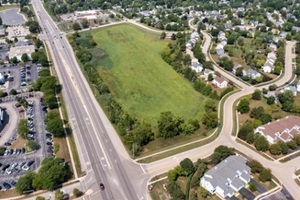 Residential land grading, a process often overlooked in property improvement discussions, is an important element in enhancing a property’s value and curb appeal.
Residential land grading, a process often overlooked in property improvement discussions, is an important element in enhancing a property’s value and curb appeal.
This article will take a closer look at the multifaceted benefits of proper land grading, revealing how this seemingly simple technique can significantly boost the overall attractiveness and financial worth of residential properties.
From preventing foundational damage to creating an aesthetically pleasing landscape, the art of land grading safeguards your investment while actively transforming your property into a visually appealing and functional space.
As we explore expert insights and practical tips, homeowners will discover the transformative impact of land grading on their property’s value and overall appeal.c
The Role of Land Grading in Residential Landscaping
As a core component of residential landscaping, land grading involves altering a property’s topography to achieve a delicate blend of stability and functionality.
It’s a process that requires precise manipulation of the earth’s surface to ensure proper runoff and prevent erosion while accommodating various structural and landscaping needs.
This technique is essential not just for aesthetics but also for the practical functionality of the property. It involves both rough and final grading and is key in constructing driveways, walkways, sidewalks, and essential utility installations such as septic and sewer systems.
Combining practicality with aesthetic appeal serves as a multifaceted approach to elevate your property’s overall value and beauty.
Benefits of Effective Residential Land Grading
Residential grading offers numerous advantages. To start, improving the drainage of your soil helps ensure that water flows away from your home, which can help prevent basement flooding and possible foundational damage.
Enhanced curb appeal quickly follows the process, as a well-graded property is both visually attractive and welcoming for potential buyers. Controlling soil erosion on your property, especially in areas with heavy rainfall, is important.
Grading stabilizes the soil while protecting the landscape, and a well-maintained and graded property can see its market value grow significantly. Also, a level landscape’s safety and navigational ease can offer much-needed peace of mind and comfort.
Understanding the Components of a Grading Plan
A comprehensive land grading plan begins with a detailed earthwork analysis of the property’s existing features, including assessing any changes in elevation, possible slopes, and natural drainage patterns. All of these are important parts of identifying potential grading solutions.
Contemporary surveying techniques allow landscapers to collect accurate landscaping data to help them craft a land grading plan. This type of data collection is imperative for helping you visualize the site’s topography and identify potential challenges.
Developing a grading plan involves meticulous consideration of the project’s requirements, including structural factors and safety considerations. For instance, residential projects focus on proper water runoff and landscaping opportunities, while commercial projects might focus on having more efficient access.
Steps in Developing a Comprehensive Land Grading Plan
 The grading plan development process starts with a preliminary site evaluation to assess the characteristics, constraints, and development potential of the site, which is important in identifying any potential challenges and possible opportunities unique to the site.
The grading plan development process starts with a preliminary site evaluation to assess the characteristics, constraints, and development potential of the site, which is important in identifying any potential challenges and possible opportunities unique to the site.
A thorough site analysis includes studying natural features, drainage patterns, and environmental conditions to develop a comprehensive understanding of the site’s grading needs.
Environmental considerations, such as wetlands or protected habitats, can greatly affect the grading plan and highlight the importance of sustainability and complying with environmental regulations. The plan undergoes several design phases, incorporating feedback and adjustments to ensure that everything aligns with any site-specific requirements and the goals of the project.
The Role of Technology in Land Grading
The use of Geographic Information Systems or GIS in land grading has revolutionized the process in recent years, providing advanced mapping capabilities and spatial analysis tools.
This software helps analyze data from a location to showcase key pieces of information, including the topography and soil, along with its drainage patterns. Analyzing these types of markers can help you better design the grade for your site.
Additionally, cutting-edge grading software and 3D modeling applications provide realistic representations of proposed grading designs, enhancing communication and facilitating early identification of potential issues.
Addressing Common Land Grading Challenges
Land grading often presents challenges, particularly when dealing with poor soil conditions such as unstable or expansive soils. Thankfully, soil remediation techniques can help you achieve a stable graded surface.
Expansive soils, which change volume with moisture content fluctuations, require specific mitigation measures, including moisture barriers and proper drainage systems, to prevent structural damage.
Addressing these challenges requires innovative strategies and expert knowledge to ensure the grading plan’s overall effectiveness and the resulting aesthetic appeal.
Navigating Land Grading Rules and Regulations
Compliance with local zoning and building codes is an important part of the overall land grading process. Understanding existing regulations concerning setbacks and potential environmental considerations is essential while developing a plan.
Compliance requirements often include erosion control, stormwater management, environmental protection, and other factors. The permitting process typically includes a governmental review of the grading plan to ensure it meets regulations.
The Long-term Benefits of Professional Grading
Investing in professional residential grading is a strategic decision with long-term benefits. Beyond immediate improvements, it offers lasting advantages in property value, environmental sustainability, and legal compliance.
A well-executed grading plan enhances a property’s current usability and beauty while ensuring its stability and adherence to legal standards over time. Employing professional grading services ensures that your property meets both current and future needs while standing as a testament to quality and foresight in residential landscaping.
Seamless Grading Solutions for Virginia and Maryland Residents
 Residential land grading is a key step to actively enhancing your property’s functionality and visual appeal. This process ensures proper drainage and structural stability and significantly boosts curb appeal and property value.
Residential land grading is a key step to actively enhancing your property’s functionality and visual appeal. This process ensures proper drainage and structural stability and significantly boosts curb appeal and property value.
With the right expertise, homeowners can overcome challenges, including managing soil conditions and meeting regulatory compliance, ensuring their property is attractive, sustainable, and safe.
If you need residential land grading services to help enhance your property’s value and curb appeal, Dirt Connections has the expertise and resources to help. Whether you’re in Virginia or Maryland, their team of professionals is equipped to provide top-notch land grading services that are carefully tailored to your property’s specific needs.
To get started, reach out to Dirt Connections by calling 1-703-940-9949 in Virginia or 1-301-691-3215 if in Maryland — or visit their website for more information. Take the first step towards improving your landscaping with Dirt Connections’ reliable and efficient land grading services.
Summary

Dirt Connections was started with one goal in mind: providing quality residential and commercial construction services to clients on time and on budget. Reach out for more information on how we can support your next project.
For your convenience our estimates are free and by appointment. Call 703-940-9949 for a free estimate today!









































